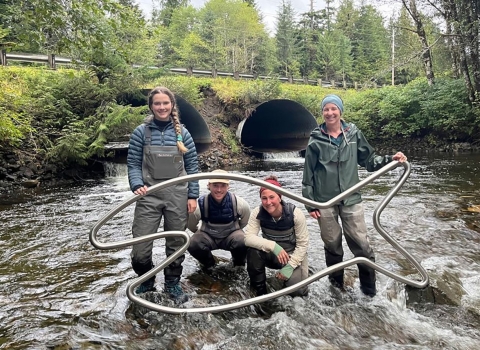Every summer, a vast majority of the United States is shrouded in thick wildfire smoke that hangs in the air like a hazy curtain, casting an eerie filter over landscapes and transforming the once-clear skies into a somber palette of muted hues. Thousands of firefighters are dispatched to distant corners of the nation to begin wildfire suppression efforts that lasts for months. At the peak of fire season, the nation can have as many as 32,000 wildland firefighters on assignment at any given time. The United States has a wildfire problem.
As wildland fire agencies, including the U.S. Fish and Wildlife Service, strive to reduce risk of wildfire to communities, the issues of recruiting and retaining wildland firefighters pose significant challenges.
The concern over recruitment and retention grows every year. Several factors contribute to the complexity of attracting and keeping personnel within wildland fire agencies: demanding nature of the work, high risk and stress levels, burnout and mental health concerns, and competitive pay. While Congress works to address firefighter pay and mental health concerns, the U.S. Fish and Wildlife Service’s Branch of Fire Management has tackled the recruitment and retention issues by addressing the competitive job market and aging workforce in new ways.
In 2022 and 2023 a film crew hired the U.S. Fish and Wildlife Service jetted across the country to capture wildland fire footage, habitats, wildlife species, fire personnel, and wildland firefighting skills for three short recruitment videos. In November 2022, filmmakers made their first filming stop at Balcones Canyonlands National Wildlife Refuge in Texas.
Next stop for the film crew brought them to Okefenokee National Wildlife Refuge in Georgia/Florida where they were promised footage of fires along with the endangered gopher tortoise. Turns out gopher tortoises are a little camera-shy, so the crew focused on the less elusive, but also endangered, red-cockaded woodpecker before capturing footage of wildlife, amphibious fire vehicles, and the FWS helicopter on multiple prescribed fires.
From burning at the best-preserved, precipitation-based freshwater wetland ecosystem in the conterminous U.S. at Okefenokee, the film crew worked their way to Turnbull National Wildlife Refuge in Washington. The film crew captured vastly different fire behavior in the Channeled Scablands ecosystem that predominates the refuge in addition moose, deer, and sleeping porcupines.
Filming was topped off with incredible footage of airboats at Big Branch Marsh National Wildlife Refuge in Louisiana and the fire-dependent, colorful blend of rare orchids, carnivorous plants, and other unique groundcover that blankets the flat landscape of Mississippi Sandhill Crane National Wildlife Refuge in Mississippi.
Once filming was complete, we released three recruitment films, each designed to target diverse, younger audiences to help shepherd in the next generation of wildland firefighters:
- Recruitment film #1 provides a two-minute intense peek into the excitement of working for our wildland fire program. This film is designed to grab the attention of younger generation thrill seekers looking for intensity in their lives.
- Recruitment film #2 offers an in-depth look into how the wildland fire program supports and enhances our overall mission, fire’s importance in creating sustainable and healthy ecosystems for plant and wildlife species, and the close-knit culture of our wildland fire program.
- Recruitment film #3 explores the upbeat, light, and fun aspect of working for our wildland fire program. This film is designed to appeal to those who may have an interest in wildland fire, but also a fear of what type of culture might greet them upon accepting a job in the field.
Recruitment and retention challenges require a multifaceted approach, including implementing strategies to promote a positive and inclusive workplace culture and targeting future recruits that emulate this culture. Collaborative efforts between government agencies, communities, and educational institutions are essential to building a sustainable and resilient wildland firefighting workforce. We hope these recruitment videos help connect communities, educational institutions, and the next generation of firefighters to wildland firefighting with the U.S. Fish and Wildlife Service.


